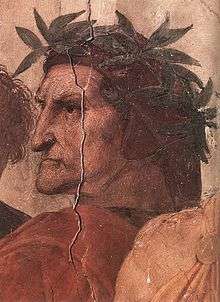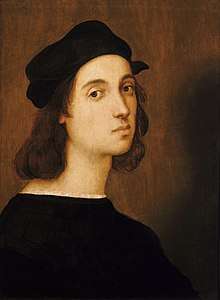Disputation of the Holy Sacrament
The Disputation of the Sacrament (Italian: La disputa del sacramento), or Disputa, is a painting by the Italian Renaissance artist Raphael. It was painted between 1509 and 1510[1] as the first part of Raphael's commission to decorate with frescoes the rooms that are now known as the Stanze di Raffaello, in the Apostolic Palace in the Vatican. At the time, this room was known as the Stanza della Segnatura, and was the private papal library where the supreme papal tribunal met.[2]
| Disputation of the Sacrament | |
|---|---|
.jpg) | |
| Artist | Raphael |
| Year | 1509–1510 |
| Type | Fresco |
| Dimensions | 500 cm × 770 cm (200 in × 300 in) |
| Location | Apostolic Palace, Vatican City |
Description
In the painting, Raphael has created a scene spanning both heaven and earth. Above, Christ is surrounded by an aureole, flanked by the Blessed Virgin Mary and John the Baptist to his right and left (an arrangement known as the Deësis). Other various biblical figures such as Peter (far left, holding keys), Adam (far left, bared chest), Paul (far right, holding book and sword) and Moses (right, with horns of light and holding tablets of the Ten Commandments) are to the sides. God the Father sits above them all in the golden light of heaven and adored by angels. Below Christ's feet is the Holy Spirit, to whose sides are books of the four Gospels held open by putti.
Below, on an altar sits the monstrance. The altar is flanked by theologians who are depicted debating Transubstantiation.[3] Christ's Body, Blood, Soul, and Divinity is the Holy Eucharist, which is discussed by representatives of the Church; among them are the original four Doctors of the Church (identified by their names inscribed into their halos), with Pope Gregory I and Jerome seated to the left of the altar and Augustine and Ambrose to the right, along with Pope Julius II, Pope Sixtus IV, Savonarola and Dante Alighieri. Pope Sixtus IV is the gold-dressed pope in the bottom of the painting. Directly behind Sixtus is Dante, wearing red and sporting a laurel wreath (symbolizing his greatness as a poet).[4] The bald figure reading a book and leaning over a railing in the left hand corner could be Raphael's mentor and Renaissance architect Bramante.
References
- Raphael, Phaidon Publishers, 1948, p. 24.
- Adams, Italian Renaissance Art, p. 344
- Adams, Italian Renaissance Art, p. 345
- Adams, Italian Renaissance Art, p. 346
Sources
- Schneider Adams, Laurie (2001). Italian Renaissance Art. Boulder: Westview Press. pp. 344–346.
External links

- The Vatican: Spirit and Art of Christian Rome, a book from The Metropolitan Museum of Art Libraries (fully available online as PDF), which contains material on this work

